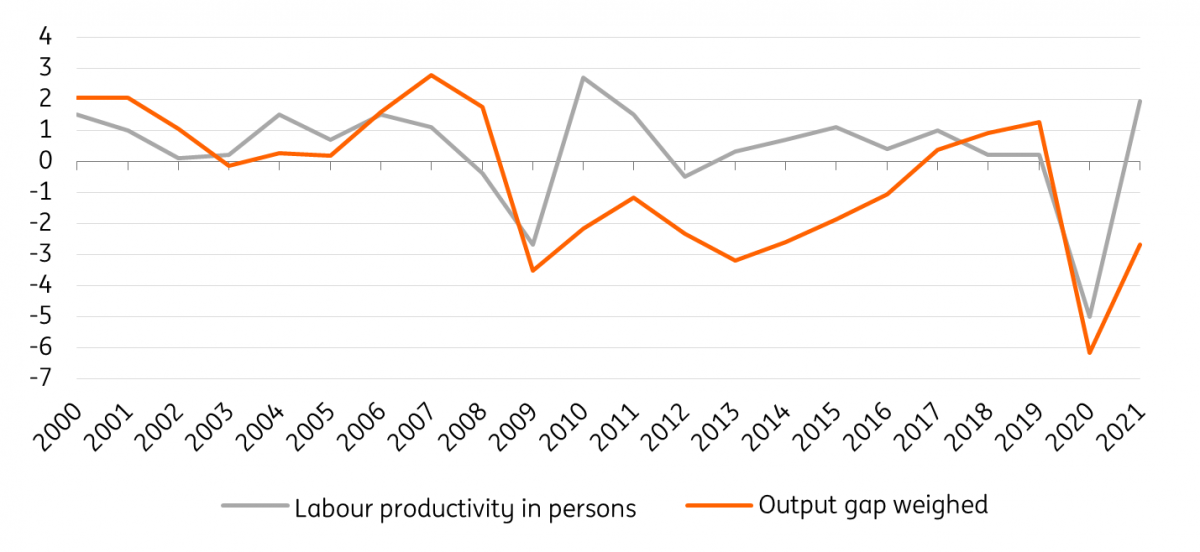Labour Costs Put Upward Pressure On Eurozone Inflation
High inflation and low unemployment will push up wage growth in 2022 and 2023. At the same time, labour productivity growth is expected to come down significantly. This makes it plausible that unit labour costs will rise by more than 2%. That would be a threat to price stability, but other drivers of inflation will come to the rescue.

Negotiated wage increases in 2022 are unlikely to fully compensate for inflation
This year, eurozone inflation has been increasing at a rapid pace. We forecast full-year inflation of 6.8% for 2022. A proportional increase in wages could prevent the loss of workers' purchasing power. The bargaining position of trade unions is relatively strong at the moment because unemployment is very low and vacancies are at an all-time high. Nevertheless, for various reasons, negotiated wage increases in 2022 are unlikely to fully compensate for inflation so that a wage-price spiral will not emerge.
Characteristics of wage formation prevent full compensation for headline inflation
The decision-making process within European unions about wage demands is time-consuming because it requires consultations and voting from members in various layers of the organisation. That is why many unions set their wage demands before the bargaining season and stick to them during that season, which normally begins at the start of the year. In 2022, this way of working will result in a sharp decline in real wages. Nominal wages can’t keep up with inflation because the inflation rates that were used to set wage demands were much lower than the current forecasts for 2022.
Another reason why negotiated wage increases in 2022 are unlikely to fully compensate for inflation is that the current inflation spike is driven by energy prices. ECB research shows that in some eurozone countries, the measures of inflation used in the wage formation process exclude price changes of energy in general (Italy) or for specific energy items like gasoline (Belgium). So this makes it even more likely that wage growth will not keep up with headline inflation and that a textbook-style wage-price spiral will not emerge in 2022.
A last but not least reason is the duration of collective bargaining contracts in the eurozone, which is on average almost two years. This means that half of the average wage growth in 2022 was already determined in negotiations last year or in 2020 when inflation forecasts for 2022 were much lower.
In practice, the contracts that are renewed this year thus far do not show many agreements with nominal wage increases that match headline inflation. In the first quarter, negotiations on average resulted in a pay rise of around 3%, of which a part is made up of one-off payments. Although we think that nominal wage growth will accelerate somewhat further this year, we expect that the average wage increase for the full year of 2022 will not be higher than 3.5%.
For next year, we expect average nominal wage growth to increase a bit further as unions, strengthened by continuing low unemployment and labour shortages in many sectors, will try to recover the loss of purchasing power that workers have experienced this year.
Will wage costs push up inflation in 2022 and 2023?
While the expected wage growth may be too low to compensate fully for inflation, it could still be high enough to keep upward pressure on inflation going and thereby threaten price stability in the eurozone. Labour cost increases of 3-3.5% are at the higher end of wage growth developments that are in line with the ECB’s inflation target of 2%. ECB chief economist Philip Lane considers wage growth of 3% still to be in line with the ECB's medium-term target of 2% inflation, as it accounts for roughly 1% productivity growth in the medium term.
With that, he touches on an important point. To see whether labour costs will put pressure on price stability we also need to look at the change in labour productivity, next to nominal wages. After all, increases in the cost of labour do not push up prices if they are fully compensated for by higher productivity of labour. In that case, the so-called labour costs per unit of production (ULC) are stable and hence labour costs do not put upward pressure on inflation.
But history indicates that it is unlikely that productivity increases will make up for labour cost increases this year and next. Productivity is, among other things, influenced by the economic cycle and when the economy switches from an upturn to a downturn, productivity growth usually diminishes sharply or even turns negative (see chart). This is due to the fact that companies cannot downsize their workforce immediately in response to a slowdown in their sales growth.
So it does not surprise that during all three recessions since the turn of the century, productivity growth turned negative in the first year (see chart).
The economy and labour productivity

Source: Eurostat
Although the pandemic and the end of furlough schemes can have unpredictable effects on employment and thereby on productivity, our base case for the period ahead is that productivity growth will come down significantly. Not only because it will, as usual, take time to downsize employment in response to the economic slowdown, but also because we expect this downsizing to be limited this time around. Given the widespread labour shortages, companies are likely to refrain as much as possible from the usual round of layoffs to avoid not being able to service extra demand once the economy recovers – especially if the downturn is mild, as we currently expect.
The combination of an increase in wage costs of 3-3.5% and a decline in productivity growth makes it very plausible that labour costs per unit of production will increase by more than 2% in 2022 and in 2023, thereby putting upward pressure on the ECB’s 2% inflation goal.
Should the ECB worry about the upward pressure on inflation?
Labour costs make up the largest part of production costs in most companies, so it deserves to be watched closely. But we expect other drivers of inflation to dominate the development of inflation in the near term. Most importantly, we forecast that energy prices will not rise as fast over the next 12 months as they did during the last 12 months. This will push down inflation strongly over the next 12 months.
Second, the steep decline of real wages in 2022 will lead to a slowdown in the growth of consumer demand and thereby also put downward pressure on inflation.
So, although labour costs will keep upward pressure on core inflation in the eurozone, we don’t expect that the increase in these costs will prevent inflation from coming down to 2% towards the end of 2023.
More By This Author:
Eurozone GDP Grew By 0.7% In The Second Quarter On Covid Tourism Rebound
FX Daily: Data Sensitivity To Keep FX Volatility High
Asia Week Ahead: Central Bank Decisions, Inflation And Manufacturing Reports
Disclaimer: This publication has been prepared by the Economic and Financial Analysis Division of ING Bank N.V. (“ING”) solely for information purposes without regard to any ...
more


